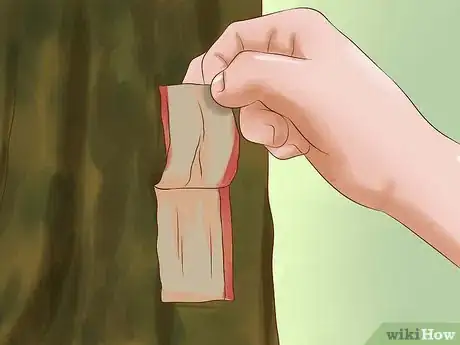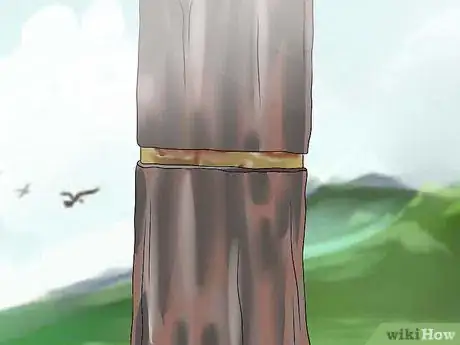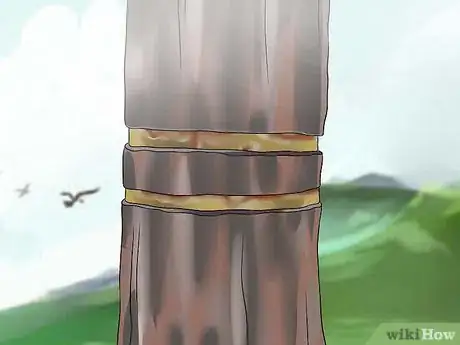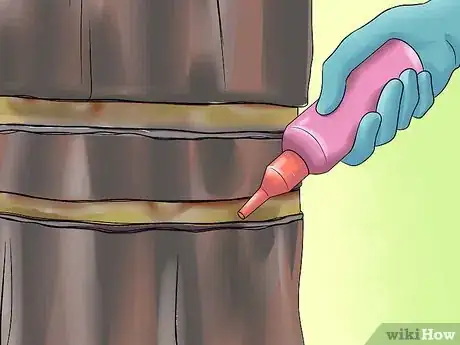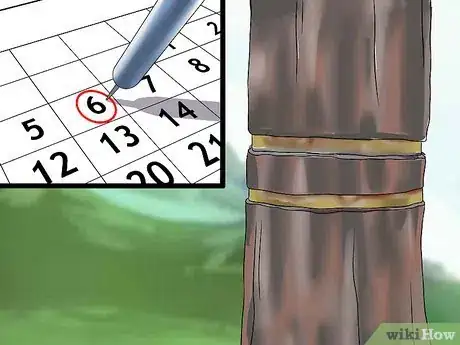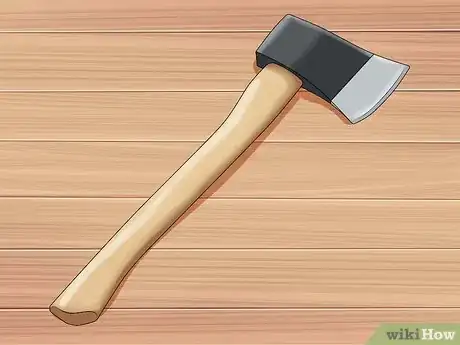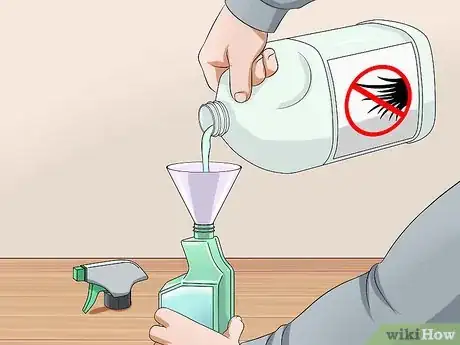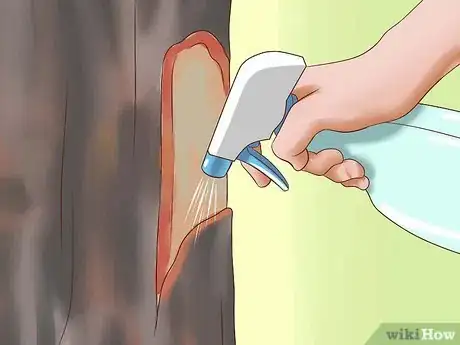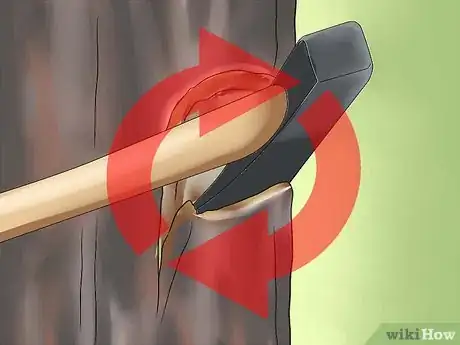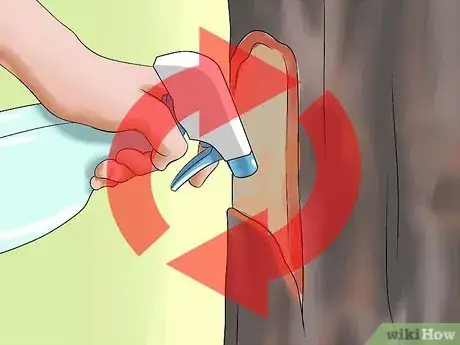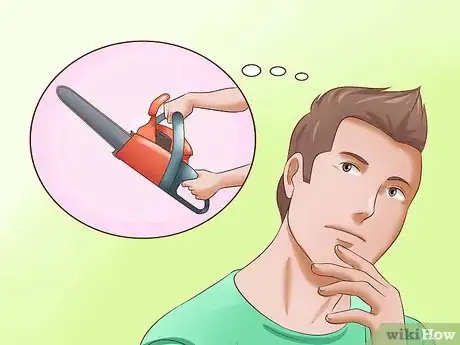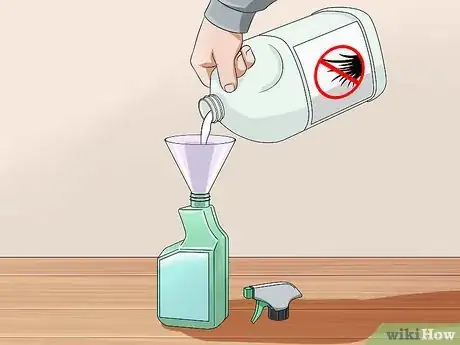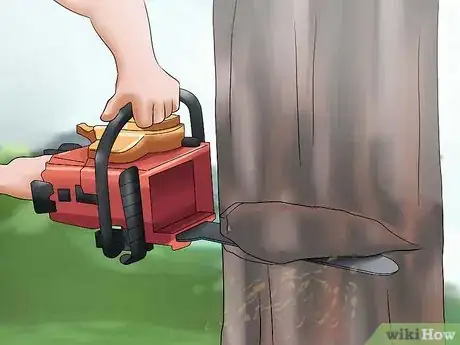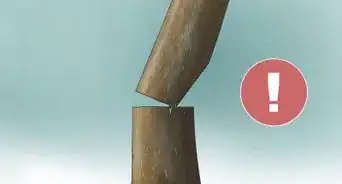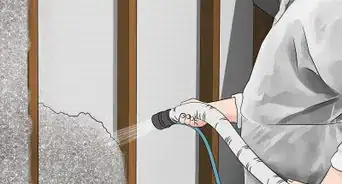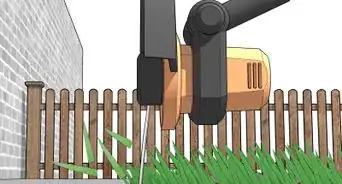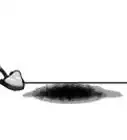This article was co-authored by Lauren Kurtz. Lauren Kurtz is a Naturalist and Horticultural Specialist. Lauren has worked for Aurora, Colorado managing the Water-Wise Garden at Aurora Municipal Center for the Water Conservation Department. She earned a BA in Environmental and Sustainability Studies from Western Michigan University in 2014.
This article has been viewed 400,645 times.
Whether a tree is invasive, ruining a view, or you simply want to plant something else in the space, there are many reasons you might want to remove a tree on your property. Oftentimes, having the tree professionally removed may prove too expensive. There are, however, a variety of ways in which you can kill the nuisance tree in order to remove it yourself once the tree is dead.
Steps
Girdling the Tree
-
1Remove any loose bark. Girdling is a method for killing a tree by interrupting the flow of sap between the roots and crown of the tree. You can girdle a tree with or without the use of herbicides to speed the process along. Girdling is the easiest and most popular method for killing a tree without chemicals or herbicides, but the tree will take many months to die from the process. Start by pulling away any loose bark that gives you easier access to the trunk.[1] You should clear the bark in a band approximately 4–5 inches (10–13 cm) wide.
- The height where you girdle the tree is flexible, so choose a level at which you’re comfortable working around the trunk and making cuts.
-
2Put on safety gear. You have a wide variety of choices when it comes to how you make the cuts. You can use a chainsaw, an axe, a hatchet, or even a wood chisel for very thin-barked trees.[2] Take the proper safety precautions for the cutting tool you use, including protective eyewear.Advertisement
-
3Make a cut around the circumference of the tree. The depth of the cut you need to make depends on the thickness of the tree. For very thin trees, you can make the cut around 1⁄2 inch (1.3 cm) into the wood whereas large, sturdy trees require a depth of 1–1 1⁄2 inches (2.5–3.8 cm). Try to make the band as level as possible as you move around the tree.
-
4Make a second cut around the circumference of the tree. To girdle the tree effectively, you will need a second band. The distance apart between the two bands should be roughly 2–4 inches (5.1–10.2 cm). Make the second cut to the same depth as the first cut.
- If you’re using an axe or a hatchet where it’s more difficult to make exact horizontal cuts, then you can cut a groove into the tree instead. To make the groove, make one downward-angled cut followed by one upward-angled cut where the two cuts meet in the middle. For small trees, this groove around the circumferences can be as small as 2 inches (5.1 cm) wide, whereas the groove should be roughly 6–8 inches (15–20 cm) wide on large trees. Make the groove to the same depth as you would the two bands.
-
5Apply herbicide. If you choose to use herbicide, you’ll want to apply it to the cuts in the tree within five or ten minutes of making them before the sections begin to dry out and harden.[3] Adding herbicide to the girdling can kill the tree in as little as six weeks whereas refraining from the chemical usage can take many months.[4]
- Commonly available, effective herbicides include glyphosate (Roundup or Killzall) and triclopyr (Garlon or Brush B Gon).[5] Please note: The WHO considers glyphosate to be a probable human carcinogen. Its use is prohibited in some states and countries. Please check with your local laws and use caution if handling this chemical.
- Mix the herbicide appropriately according to the directions on your specific brand and apply to the cuts with a spray bottle.[6]
- You should definitely mix the herbicide ahead of time in order to apply it to the girdling cuts as quickly as possible.
- Read the label entirely before mixing or using herbicides.
- Wear eye protection, long sleeves and pants, gloves, and closed-toe shoes when working with any herbicide.
-
6Wait. Now that you’ve interrupted the flow of sap in the tree and possibly introduced herbicide to the root system, you simply have to wait for the tree to die.
Using the Hack and Squirt Method
-
1Get an axe or a hatchet. If you do plan to use herbicide on the tree, then the hack and squirt method can be just as effective as the girdling method with even less work involved. The hack and squirt method uses precise chops to coat with herbicide instead of an entire band around the whole tree. Start by getting an axe or a hatchet.[7]
-
2Mix the herbicide in a spray bottle. The hack and squirt method requires fewer cuts than girdling, but you will still use the same herbicides. Read the entire label on the herbicide to figure out how much to make. Mix the herbicide in a spray bottle before you begin cutting.
- Commonly available, effective herbicides include glyphosate (Roundup or Killzall) and triclopyr (Garlon or Brush B Gon).[8]
- Wear protective clothing, like safety glasses, long sleeves, and gloves before working with any herbicide.
-
3Make a downward cut into the tree trunk. Using the axe or hatchet, make a downward cut into the trunk of the tree roughly 2 inches (5.1 cm) long. The cut needs to be deep enough to get into the lighter-colored sapwood, so you can effectively introduce the herbicide.
-
4Spray herbicide into the cut. Once you have made the cut, pull the head of the axe or hatchet to the edge of the cut rather than out completely. Then use the spray bottle to spray the herbicide down the top side of the hatchet, allowing it run down into the deep sapwood portion of the cut.[9]
- Make sure you spray in the herbicide immediately before the softer wood in the cut has a chance to start drying out and hardening.
- Your specific brand of herbicide will instruct you regarding how much herbicide to spray into each cut.
- Various specially made injectors are also available for this purpose if you need to treat several trees.
-
5Repeat the downward cuts as directed. Your specific brand of herbicide will have directions for how many cuts you need to make based on the circumference of the tree. Most trees will require additional cuts with the spacing 1–3 inches (2.5–7.6 cm) apart from edge to edge.
-
6Keep adding herbicide to each cut. For each cut in the trunk that your brand of herbicide suggests, you want to add the same amount of herbicide. Continue using the injector or the flat side of the axe or hatchet to spray the herbicide into the cuts until you’ve gotten each one.
Removing the Tree and Treating the Stump
-
1Take all of the proper safety precautions. Unlike the other methods that require leaving the tree standing, this method involves cutting the tree down, making it the best method for trees blocking a view or any other reason where you want the tree gone immediately. Since you will have to cut the tree down, start by taking every precaution involved with operating the chainsaw and keeping the area where the tree will fall secured.
-
2Mix the herbicide. As with the other herbicidal methods, you will need to coat the cuts with glyphosate or triclopyr as soon as the tree has been cut down. Read the herbicide’s label before mixing it in a spray bottle prior to cutting down the tree.
- Wear safety glasses, gloves, and long sleeves before working with the herbicides.
-
3Cut down the tree. For smaller trees, the tree’s drop zone is much shallower and easier to work with, but if you’re dealing with a larger tree, you will need to take more precautions in cutting it down. For a full explanation of how to cut down the tree safely, check How to Fell a Tree.
- For large trees, consider hiring a professional to cut down the tree for you.
-
4Apply a coating of the herbicide to the top of the remaining trunk. Many people don’t realize that cutting down a tree alone does not kill the root system. Often, the root system will send up new sprouts instead. By applying a coating of herbicide to the exposed sapwood in the trunk, you can treat the root system and keep it as well.[10]
- For smaller trees, you can simply coat the entire cross section of the trunk. For large trees, the hardened middle section of the tree will not absorb any herbicide, so you can simply coat a band of the herbicide around the outermost ring where you can still see the lighter-colored sapwood.[11]
Expert Q&A
Did you know you can get expert answers for this article?
Unlock expert answers by supporting wikiHow
-
QuestionIs it bad to water a tree by spraying the whole tree down all the time?
 Lauren KurtzLauren Kurtz is a Naturalist and Horticultural Specialist. Lauren has worked for Aurora, Colorado managing the Water-Wise Garden at Aurora Municipal Center for the Water Conservation Department. She earned a BA in Environmental and Sustainability Studies from Western Michigan University in 2014.
Lauren KurtzLauren Kurtz is a Naturalist and Horticultural Specialist. Lauren has worked for Aurora, Colorado managing the Water-Wise Garden at Aurora Municipal Center for the Water Conservation Department. She earned a BA in Environmental and Sustainability Studies from Western Michigan University in 2014.
Professional Gardener
-
QuestionAre there any other substances we can apply after cutting the tree in case we don't have herbicide?
 NinoxTop AnswererYou can use Epsom salt (magnesium sulfate) or rock salt (sodium chloride). You can also benzine and burn the trunk.
NinoxTop AnswererYou can use Epsom salt (magnesium sulfate) or rock salt (sodium chloride). You can also benzine and burn the trunk. -
QuestionHow do I kill the roots of a tree that I previously cut down?
 Community AnswerFollow the steps as shown above. Be careful of re-girdling the stump though, it's an easy way to cut yourself.
Community AnswerFollow the steps as shown above. Be careful of re-girdling the stump though, it's an easy way to cut yourself.
References
- ↑ https://www.youtube.com/watch?v=PFhLAn680Fs
- ↑ https://www.youtube.com/watch?v=ZZzUu0TZCds
- ↑ https://www.youtube.com/watch?v=ZZzUu0TZCds
- ↑ https://www.youtube.com/watch?v=ZZzUu0TZCds
- ↑ https://www.youtube.com/watch?v=ZZzUu0TZCds
- ↑ https://www.youtube.com/watch?v=CGM1VsTQoQg
- ↑ https://www.youtube.com/watch?v=CGM1VsTQoQg
- ↑ https://www.youtube.com/watch?v=ZZzUu0TZCds
- ↑ https://www.youtube.com/watch?v=CGM1VsTQoQg
About This Article
If you want to kill a tree with a pesticide spray, mix the pesticide ahead of time and then chop down with an axe to make a 2” deep cut into the tree. Next, spread the wound open and spray the pesticide into the cut. Repeat that process a few times on different sides of the tree, based on the directions for your pesticide. Using this method, the tree should die in as little as 6 weeks. Read more to learn how to kill a tree by girdling it or chopping it down.
